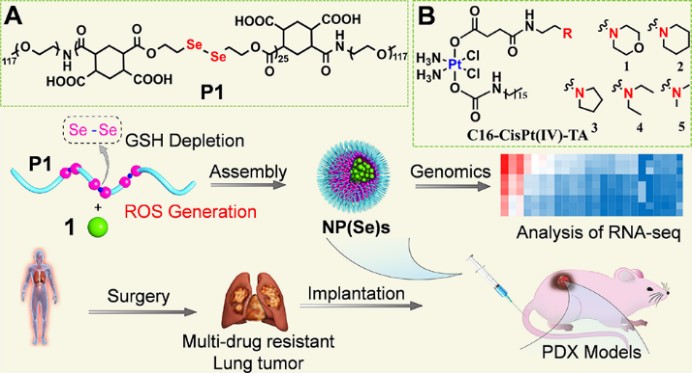Breaking the Intracellular Redox Balance with Diselenium Nanoparticles for Maximizing Chemotherapy Efficacy on Patient-Derived Xenograft Models
Dengshuai Wei,& Yingjie Yu,& Xingcai Zhang, Yongheng Wang, Hao Chen, Yao Zhao, Fuyi Wang, Guanghua Rong, Wenwen Wang, Xiang Kang, Jing Cai, Zehua Wang, Ji-Ye Yin, Muhammad Hanif, Yongbing Sun, Gaofeng Zha, Linxian Li, Guohui Nie, and Haihua Xiao*
ACS Nano 2020, 14, 16984-16996
Excessive oxidative stress in cancer cells can induce cancer cell death. Anticancer activity and drug resistance of chemotherapy are closely related to the redox state of tumor cells. Herein, five lipophilic Pt(IV) prodrugs were synthesized on the basis of the most widely used anticancer drug cisplatin, whose anticancer efficacy and drug resistance are closely related to the intracellular redox state. Subsequently, a series of cisplatin-sensitive and drug-resistant cell lines as well as three patient-derived primary ovarian cancer cells have been selected to screen those prodrugs. To verify if the disruption of redox balance can be combined with these Pt(IV) prodrugs, we then synthesized a polymer with a diselenium bond in the main chain for encapsulating the most effective prodrug to form nanoparticles (NP(Se)s). NP(Se)s can efficiently break the redox balance via simultaneously depleting GSH and augmenting ROS, thereby achieving a synergistic effect with cisplatin. In addition, genome-wide analysis via RNA-seq was employed to provide a comprehensive understanding of the changes in transcriptome and the alterations in redox-related pathways in cells treated with NP(Se)s and cisplatin. Thereafter, patient-derived xenograft models of hepatic carcinoma (PDXHCC) and multidrugresistant lung cancer (PDXMDR) were established to evaluate the therapeutic effect of NP(Se)s, and a significant antitumor effect was achieved on both models with NP(Se)s. Overall, this study provides a promising strategy to break the redox balance
for maximizing the efficacy of platinum-based cancer therapy.

